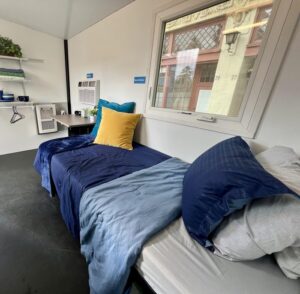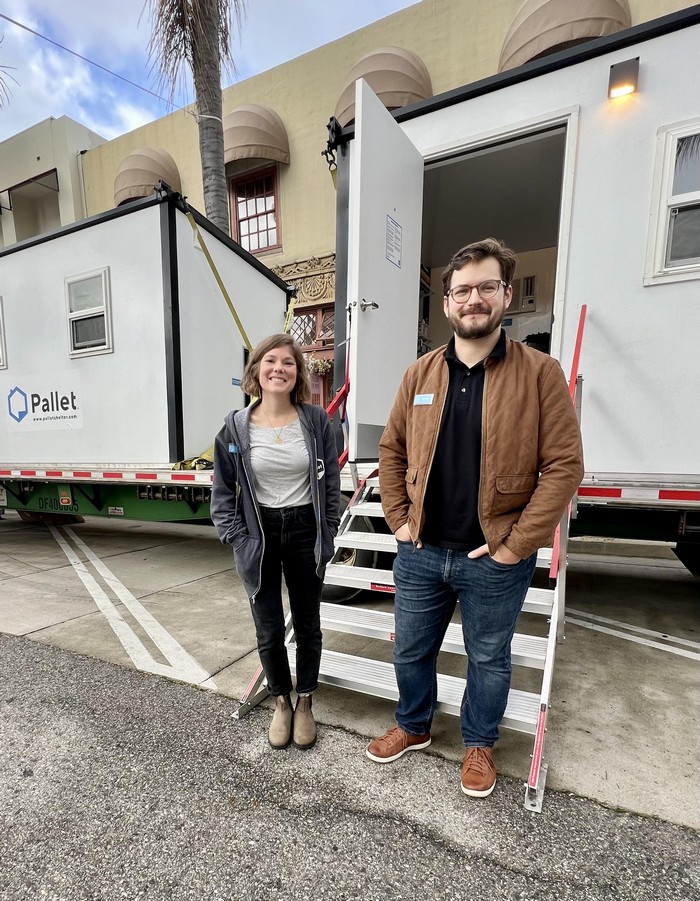Elizabeth Rugg Pallet Community Development Manager and Ted Sweeny representative for Pallet in front of a Pallet shelter.
by Patricia Schallert
On January 25th, The City of Ventura hosted a tour of two pallet shelters. Demonstrating an innovative model with proven results, Elizabeth Rugg stated that “Pallet shelters are cost-effective, rapid to install and have the capacity to serve people displaced by global conflict, disasters or chronic homelessness.”
Stated Patrick Diller “While finding suitable land for shelter villages can seem like a complex and challenging process, it is not impossible. By making a commitment to ending unsheltered homelessness, it is possible to find solutions that benefit unhoused individuals and the community as a whole.”
 Pallet living shelters represent more than just a practical solution for housing the unhoused; it embodies a larger vision of community, sustainability, and social responsibility. According to Ted Sweeney, a Pallet representative, “by working together to build and maintain shelters, individuals form supportive networks based on mutual respect and shared experiences.The importance of collaborative efforts within the Ventura community cannot be overstated. It includes volunteers, organizations, and the unhoused themselves. This fosters a sense of collective responsibility and empowerment, where individuals actively participate in creating solutions to address homelessness.”
Pallet living shelters represent more than just a practical solution for housing the unhoused; it embodies a larger vision of community, sustainability, and social responsibility. According to Ted Sweeney, a Pallet representative, “by working together to build and maintain shelters, individuals form supportive networks based on mutual respect and shared experiences.The importance of collaborative efforts within the Ventura community cannot be overstated. It includes volunteers, organizations, and the unhoused themselves. This fosters a sense of collective responsibility and empowerment, where individuals actively participate in creating solutions to address homelessness.”
The Pallet organization recognizes the inherent dignity and rights of unhoused individuals. By providing safe and secure shelter, it affirms their right to adequate housing and challenges social stigmas associated with homelessness.
Social networks and support systems can easily be created through Pallet living shelters and can offer encouragement, and mutual aid to unhoused individuals. Coordinating efforts with law-enforcement, mental health services, medical services, code enforcement, social workers and sanitation while providing emotional support, practical assistance, and a sense of belonging.
In addition to the basic shelter provided by Pallet living shelters supplementary services can enhance the well-being and sustainability of unhoused communities along with access to healthcare services, including medical clinics, mental health support, and substance abuse treatment.
 The Sleeper (70sq ft) and the EnSuite 120sq ft. showed two fully-built shelters with industry-leading design features such as a mono-pitch roof, and a smooth exterior and interior panel. The Sleeper houses one or two, and the EnSuite includes in-unit hygiene facilities. Pallet shelters were designed by people who had lived experience in homelessness .
The Sleeper (70sq ft) and the EnSuite 120sq ft. showed two fully-built shelters with industry-leading design features such as a mono-pitch roof, and a smooth exterior and interior panel. The Sleeper houses one or two, and the EnSuite includes in-unit hygiene facilities. Pallet shelters were designed by people who had lived experience in homelessness .
Residential energy efficient windows, locking doors and peepholes, smooth interior walls, easily accessed interior lighting, and climate control offer comfort and privacy. Interior storage and space allows residents to keep possessions and pets, while the customizable shelving system and freestanding bed and desk are designed for simple modification – making each shelter a personalized space to recharge.
These pallet shelters can be manufactured inexpensively, deployed and assembled with urgency, and act as a short-term solution for cities like Ventura to aid their unhoused communities—all while providing comfort for residents. Units can be easily moved by forklift or disassembled and stored, preventing the possibility of becoming costly, long-term housing that isn’t dignified.
There is no one solution to end homelessness. Ventura, like many communities have their own specific needs. While Pallet villages coupled with supportive services are a successful model, there are many other strategies to address the homelessness crisis. Working closely with cities across the country, Pallet realize communities want to find the right solutions and “know our expertise and learnings from deploying over 100 shelter villages could help them drive change.” By connecting village residents to housing navigation, job assistance, and a stable food source right where they live, unhoused individuals can start on the path to permanent housing.

